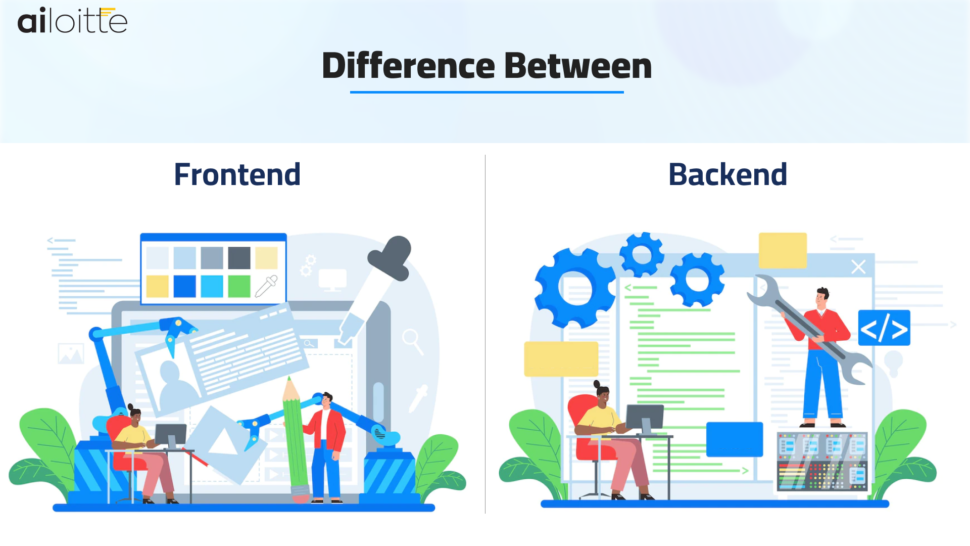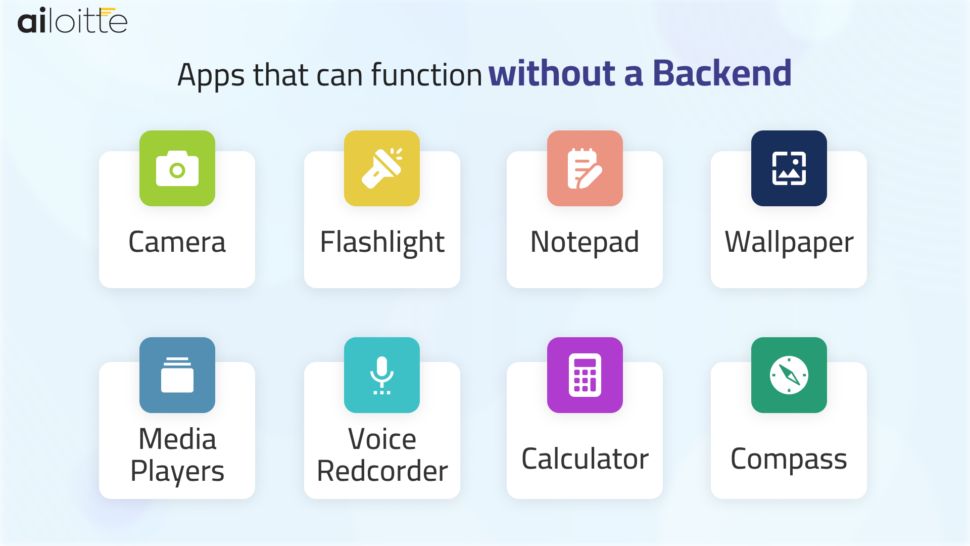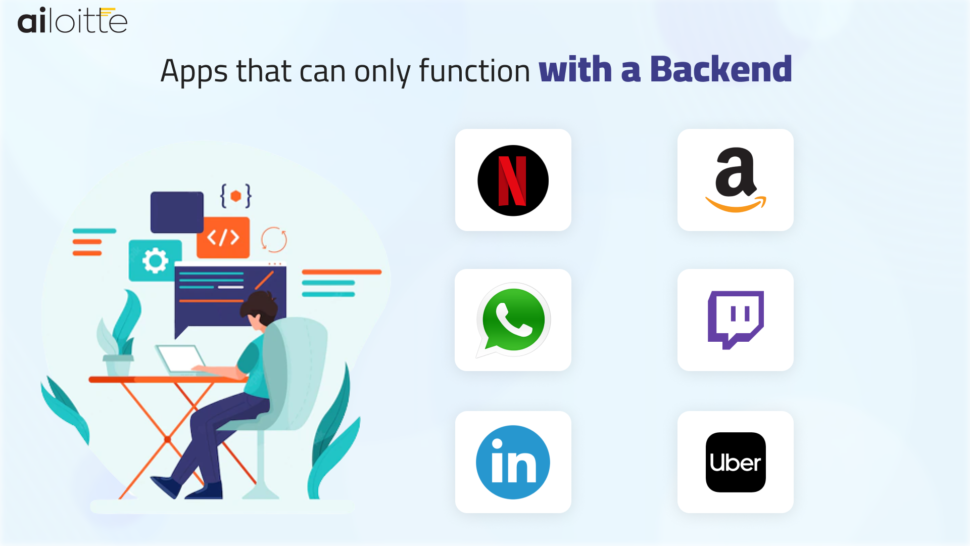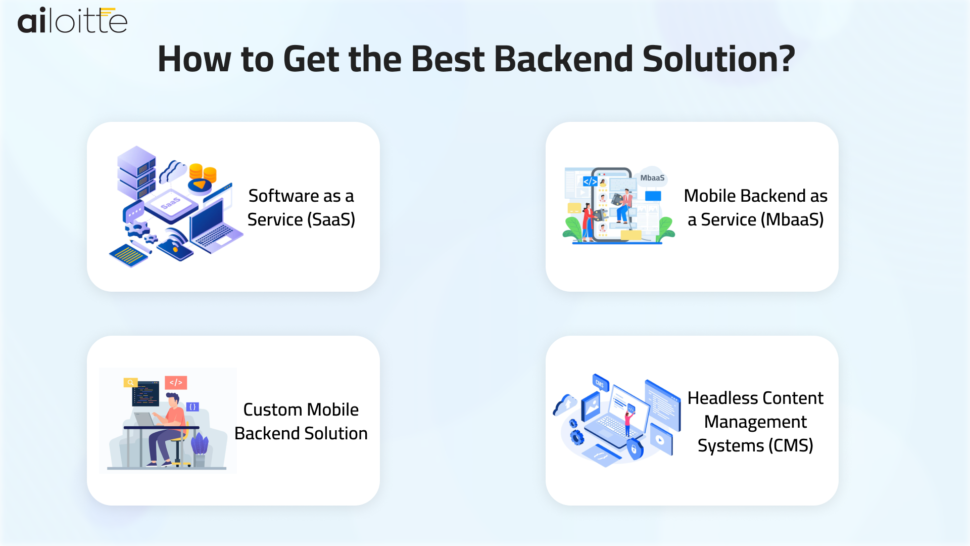A mobile app with an attractively simple user interface is only possible with effective backend development. The backend for mobile apps is like the base of an app. It has a symbiotic connection with the frontend of a mobile app, meaning one can only perform well if the other does. This is why the frontend and backend app development tools have more value now than ever.
The value of backend developers will also keep increasing as more and more businesses use mobile apps/websites to improve their digital presence. Business owners must know exactly how to choose the suitable backend development tool for the best results and understand how different ones contribute to the mobile app development process.
What is Backend Development for Mobile Apps?
Mobile App Backend Development is the server-side development of an app. The backend frameworks in mobile apps consist of a server, database, and application that help process information received through the frontend. The backend responds to that information remotely to improve the frontend response for users. For example, the backend part of a motorbike would be its engine. The motorbike will not run without its engine and mobile apps need the backend frameworks to keep the frontend functional.
Some crucial things the mobile app backend server manages are functionality, security, data storage, and data processing of a mobile app.
Going by our previous description, the apps that do not have or need the backend are like bicycles that do not need an engine to run. Any application with user authentication, login/signup, user data storage, and push notification features needs mobile app backend services.
The backend for mobile apps stores and provides a response that the frontend can present to the user. For example, when you click on a particular section like clothes for men or women in the Amazon app, the backend sends that information request quickly to the backend. The application backend processes request and search through the database of clothes for men/women. Then it provides the best options that the frontend then presents to the users.
The mobile app backend server manages the database, application scripting, architecture, data processing, data sharing, security, database updates, and user data authentication.
Difference Between Frontend and Backend
The frontend code is the visual interface of an app and the backend code manages the functionality of the backend. Frontend coding focuses on the visual factors of an app like font, color, line, shape, form, sliders, and texture. Its designers develop such elements with HTML, CSS, and JavaScript.

The backend is all about server-side functionality that includes database management, data storage, and security. Backend is the base that the frontend requires to function smoothly and ensure that the end user has a satisfactory experience on the app. An app and its user interface can only function properly with mobile backend services.
Apps that can function without a Backend
Certain apps do not have a backend as they do not need the internet or data storage to function.

Apps that can Only Function With a Backend
Every app today with the internet, data storage, data exchange, and user authentication requirements need a backend to function smoothly.

Types of Backend Solutions
Mobile app backend development is a process that can require various backend frameworks depending on your requirements. You can analyze them carefully to determine how they all interact with the frontend apps and this will help you choose one that meets every one of your requirements. In the end, your primary focus should be on the reliability and scalability of the backend software.

Software as a Service (SaaS)
Various 3rd parties/SaaS provide backend functionality solutions for the frontend apps. You may have to pay a monthly/annual subscription fee to get this ready-to-use backend solution. All you need to do is subscribe and integrate it with the frontend of your app and your app will be ready to use with a functional backend. The SaaS also simplifies API integration for the frontend app.
Mobile Backend as a Service (MbaaS)
The backend solutions include a database, application server, and security. What makes Mobile Backend as a Service (MbaaS) different is that it provides an option to customize the code with pre-built backend tools and APIs. You can use this function to add and modify the app features according to your requirements. Apps that need push notifications, data storage, and user authentication need a reliable backend that MbaaS can provide.
The custom code functionality of MBaaS helps frontend app owners customize the app to meet the changing business requirements. You have to pay a monthly fee depending on the utilization of MbaaS solutions like user slot usage and notifications.
Custom Mobile Backend Solution
A custom backend solution is a superior option for complex feature app development. You can design every element of your app backend exactly how you want it with custom solutions.
However, the app requirements can be excessive and complex sometimes, which is why building a custom backend solution will require expert backend developers.
Headless Content Management Systems (CMS)
Apps that require media like images, videos, or texts can benefit from a CMS backend development solution. Future Market Insights reports that the market value of the Headless CMS Software Market Size is $605 million in 2022.
- A headless CMS can help you build a frontend framework with a custom design and medium.
- Content creation/management becomes faster and easier with APIs that come with CMS.
- A headless CMS backend can also provide multi-platform compatibility for your app.
- Choosing a headless CMS as a backend will also ensure better security and scalability for your app.
Advantages of Backend Development
Backend app development is an essential aspect of many complex apps. The backend determines how the app will function and meet the user’s needs, while the frontend determines the visual experience of the app for users.
Here are some usual benefits of backend development:
Better Information Exchange
Backend enables a smooth interaction between the external and internal elements of an application to increase the efficiency of information exchanges that take place in the app.
Accelerated Development Process
Backend is technically the brain of the application, so building the backend systematically speeds up the rest of the states in development.
Better Frontend Functionality
The backend streamlines the internal processes of an application to support and automate the functions of the frontend, improving the user experience of the application frontend.
Improved App Performance
As mentioned before, the backend is the brain of your mobile application. It processes information requested by the user through the front-end to deliver the best solutions. A well-developed backend can help create high-performance mobile applications.
Tools you can use for Android Backend Development
Android apps require backend solutions from well-designed backend software. You can check out the best backend for Android apps to choose the suitable one for your requirements.
- Firebase
- Parse
- Amazon Web Services (AWS)
- Back4App
- Google App Engine
- Heroku
Tools you can use for iOS App Backend Development
Data storage and syncing for iOS can be complex if you do not choose suitable software according to the requirements of your app.
Here are some iOS backend development technologies you can choose:
- AWS Amplify
- Firebase
- Rest API
- CloudKit
- StackMob
- Back4App
- Parse
- GraphQL
Tech Stack for the Backend Mobile App Development
Mobile backend development for both a standard and complex app requires experienced developers. Hiring such developers individually or onshore can prove costly for a project with a fixed budget. You can outsource to offshore developers for mobile backend development. They provide similar development solutions for a lot less money. Choosing the right technology for your mobile app backend architecture is also easy with experienced backend developers. You can make yourself familiar with the tech stack to ensure you are headed in the right direction.
Here are the tech stacks you may need for backend development:
Tech Stack for Backend Development
| Programming languages | Frameworks | Web Servers | Databases | API |
| JavaScript | Laravel | Apache | SQL or NoSQL | JSON API |
| PHP | Django | Nginx | MongoDB | REST API |
| Python | Ruby on Rails | Internet Information Server (IIS) | PostgreSQL | GraphQL |
| Ruby | MySQL | XML | ||
| TypeScript |
Final Note
The app requirements will help you determine the type of backend your app will need to function smoothly. An app with basic/standard features may only need ready-to-use SaaS backend solutions, but a complex app that needs updates every other month will need an MBaaS or custom mobile backend solution.
You can do this right by going through multiple backend developers to find a suitable one and consulting with an established software/mobile app development company to get reliable guidance. It will help you choose the right backend solution for your app.
Frequently Asked Questions
The backend is the unseen element of an app known as the server-side. It is responsible for data storage, security, and data processing. App users never have to interact with the backend. But they interact with the frontend that relies on the backend to function properly. In short, the backend performs remote tasks with security, data storage, management, and processing to ensure the frontend performs well for the end user.
You must determine the requirements of your app to figure out which backend development solution is most suitable for your project. Some well-known backend development solutions are Software-as-a-Service, Mobile-Backend-as-a-Service, Custom Backend Development, and Headless CMS.
You need to know your app requirement to determine which backend framework is the most suitable for your app. You can also consult professional app developers to get guidance on choosing the framework. Some top backend frameworks include Django, Laravel, ExpressJS, Ruby on Rails, and Spring Boot.
A backend developer needs extensive knowledge and experience with programming languages, backend frameworks, databases, data structures, servers, and APIs. One of the easiest ways to find a competent one is by checking the developer portfolio and examining the past backend projects the developers have done. It will help you understand what you can expect from the candidate.
Some of the best languages for backend development are Node.js, Python, PHP, Swift, C#, Objective-C, Flutter, React Native, and HTML5.
The mobile app backend includes a server, database, and application. It is responsible for data storage, data processing, and security. Backend automates the functionality accessed by users on the frontend. It is the unseen feature of an app that improves the frontend(Visual) experience for users.


















.png)
.png)
.png)



This blog post is a great introduction to mobile app backend development. It covers the essentials in an easy-to-understand way, and provides valuable insights for both beginners and experienced developers. I especially appreciate the breakdown of the different backend solutions and the factors to consider when choosing one. Thanks for sharing!
Great post! For unparalleled market insights and research resources tailored specifically to the market research industry. Looking forward to more engaging content from you!